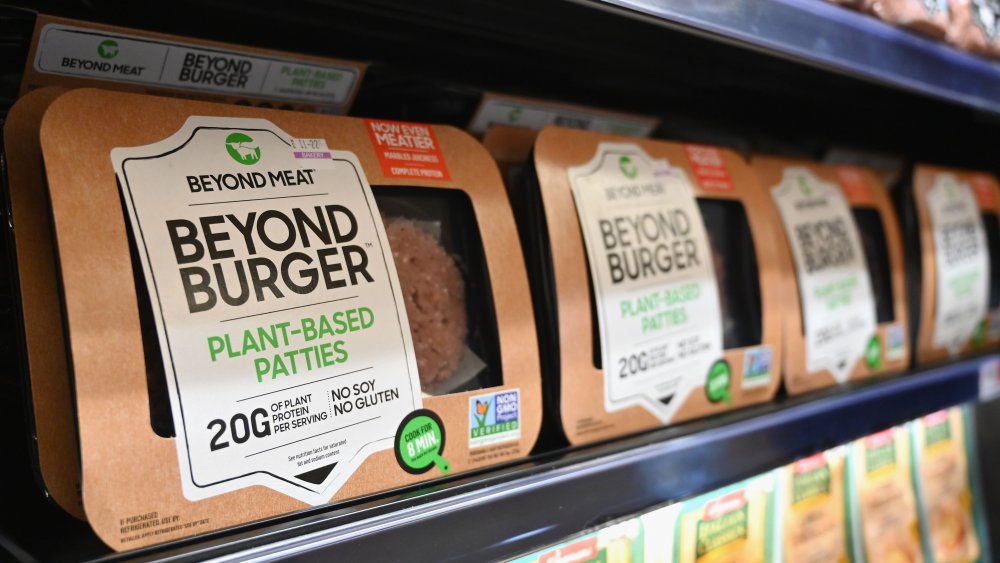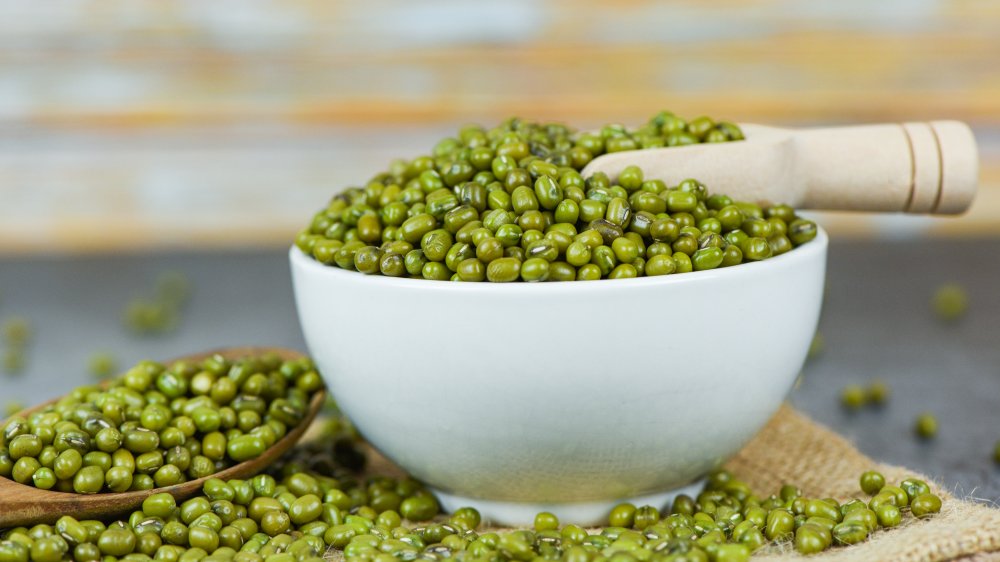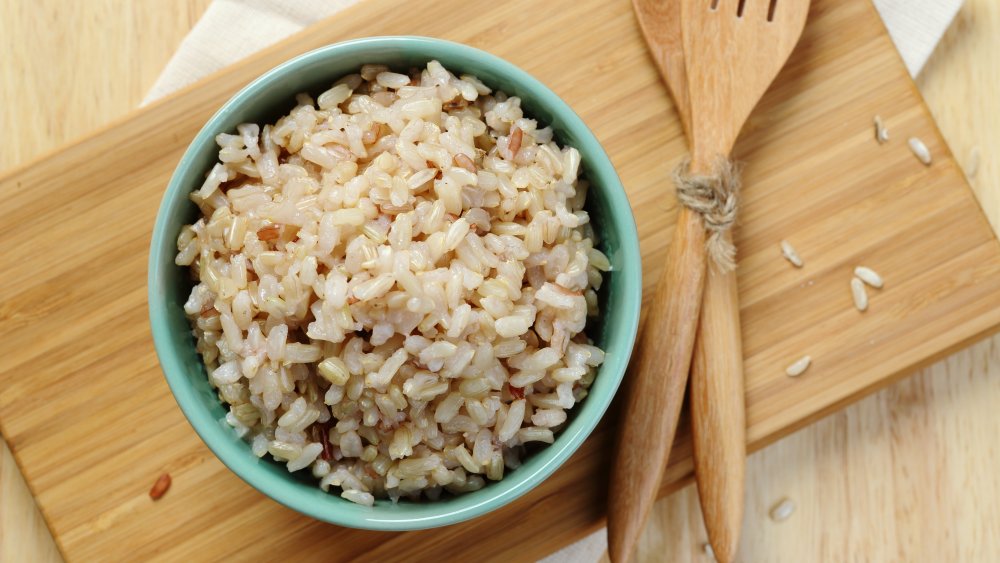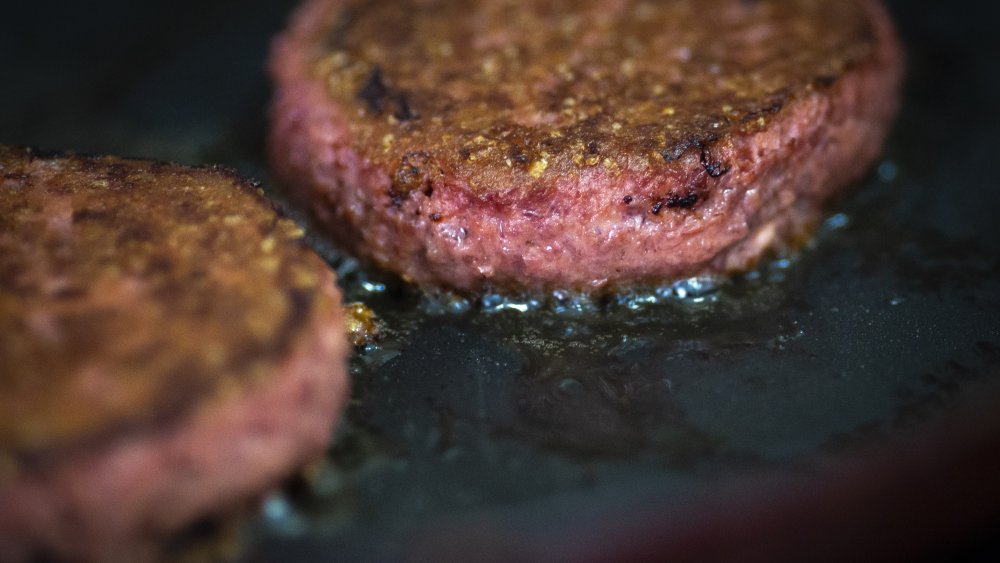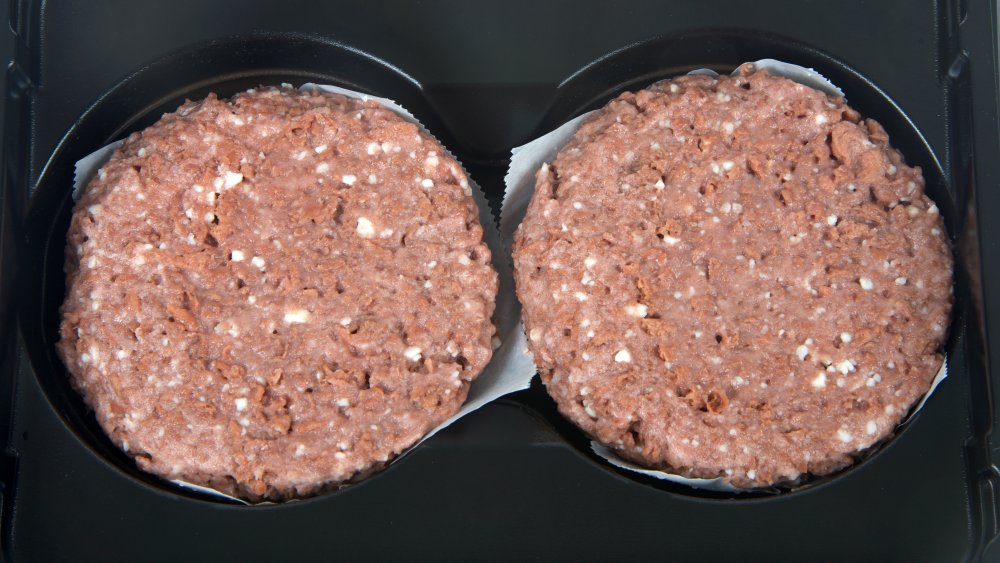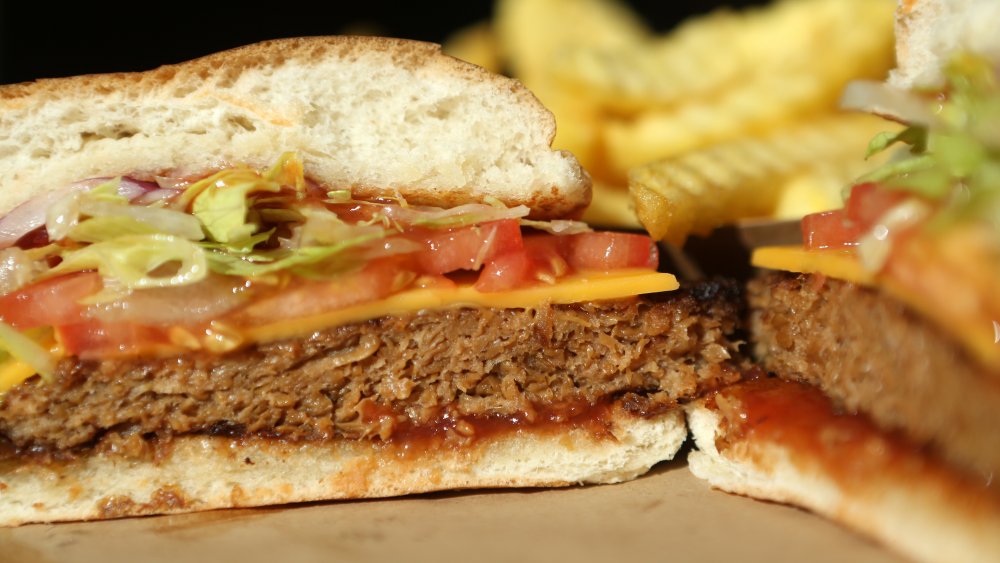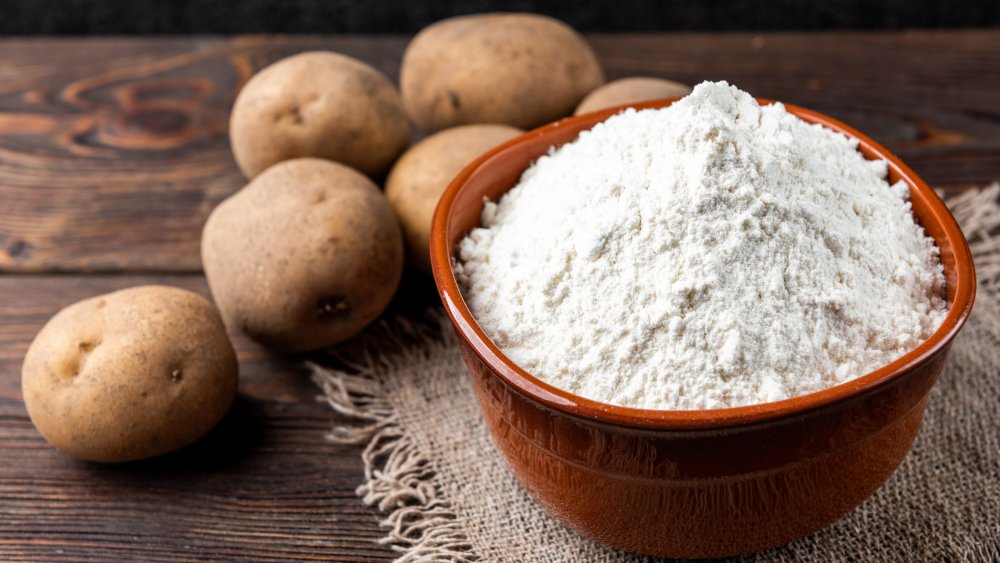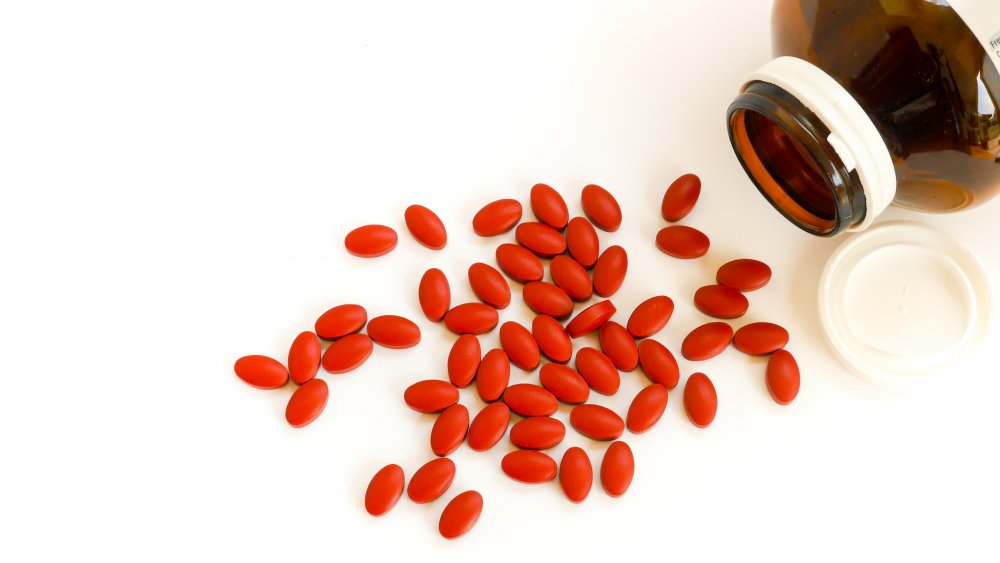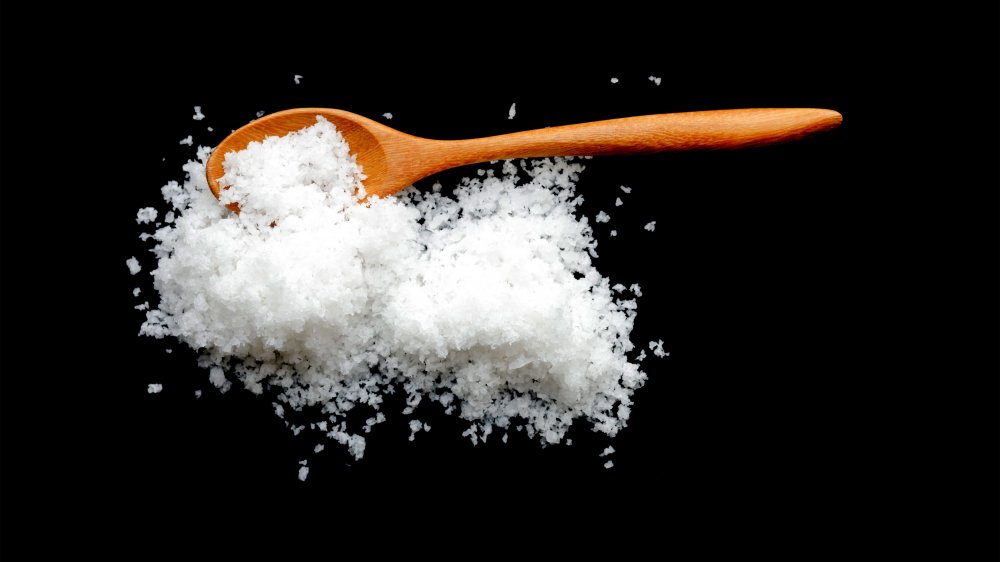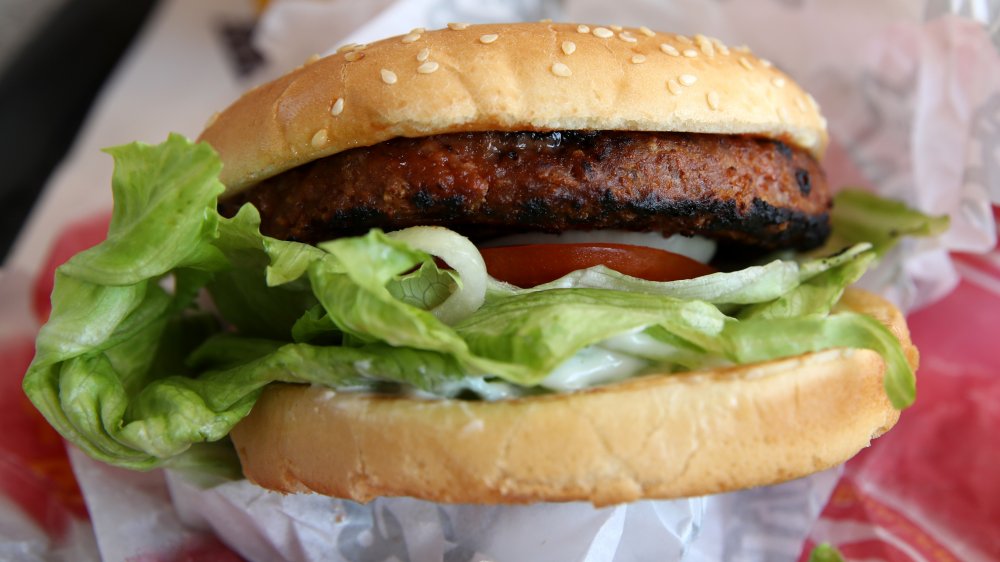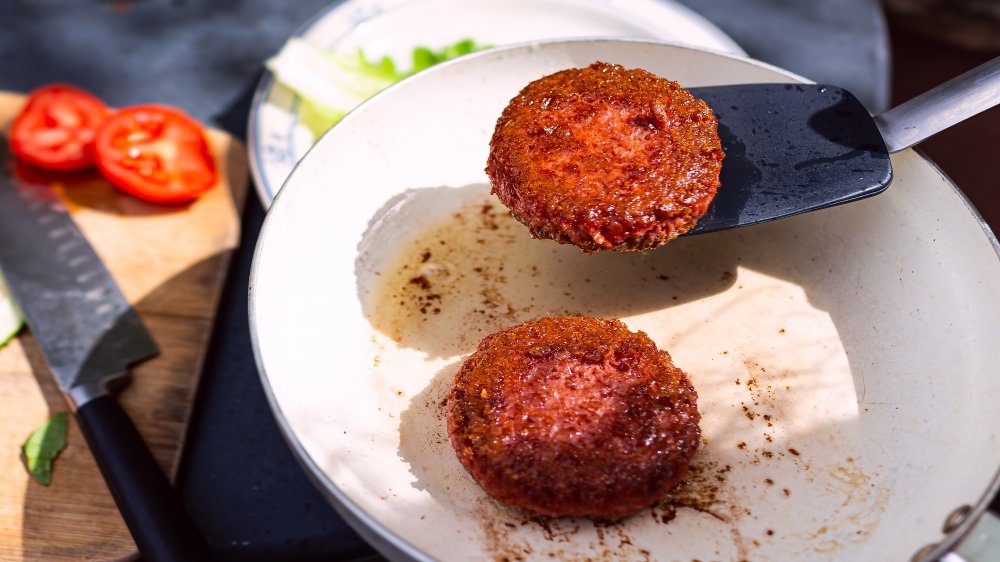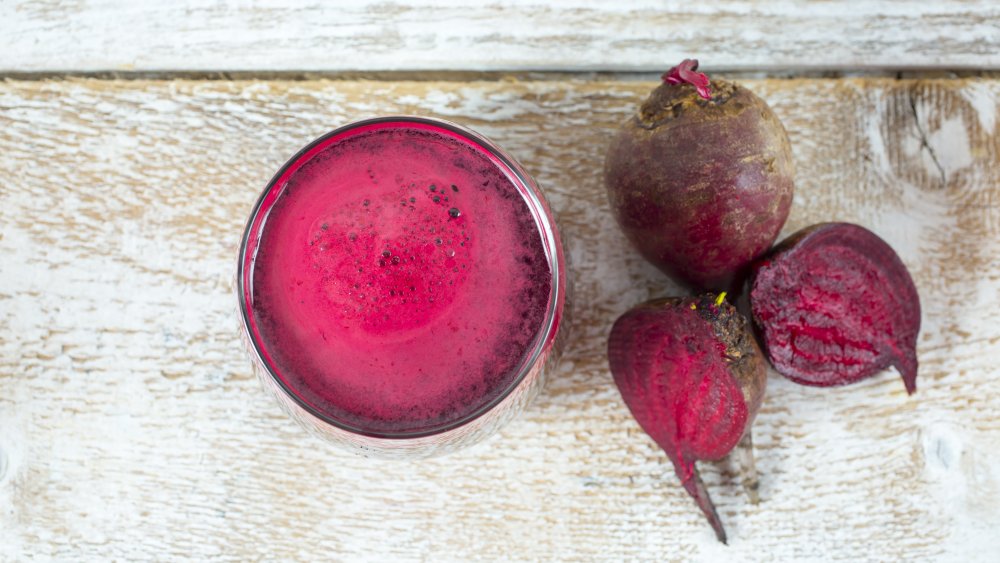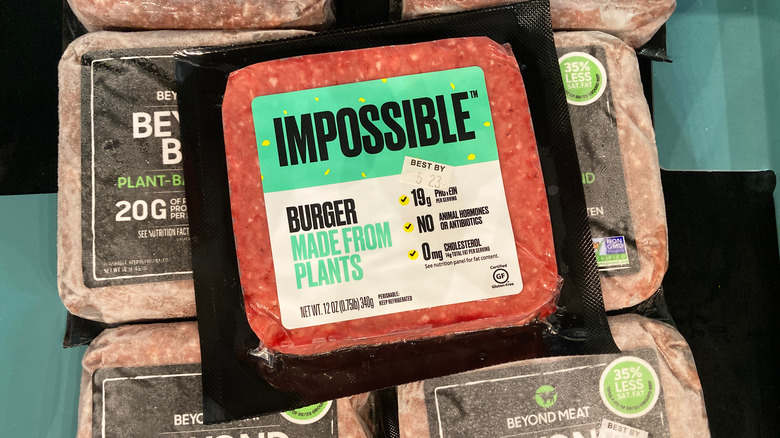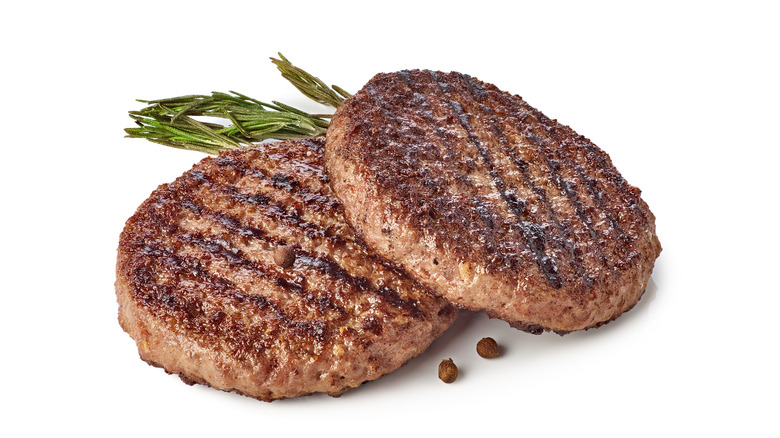What You're Really Eating When You Eat A Beyond Burger
It sizzles. It browns. It even drips heavenly juices into the crevices of your fingers. It tastes like a delicious beef patty — but it's got more beets than beef.
It's the Beyond Burger, and with its competitors in the plant-based meat industry, this vegan alternative has revolutionized the good ole' fashioned American burger. Made entirely of plants and plant derivatives, the recipe for a Beyond Burger is as much technology as it is ingredients — ingredients that have to somehow transform from peas, beans, and coconut into a marbled, pink and red patty that cooks, looks, and tastes just like beef.
At first glance, the Beyond Burger seems almost like witchcraft in its optical illusions and flavor enhancements, or, in other words like a whole lot of processing. This has led to some concern regarding its health benefits, and whether it's actually any better for you than a traditional beef patty. But as a spokesperson from Beyond argued, "There's a difference between processed and a process."
Out of the 18 ingredients listed on Beyond's website, some are familiar, like brown rice and salt. Others, like methylcellulose, are a little less so. We took a look at those to figure out what they were, and how exactly one turns plants into "meat." This is what you're really eating when you eat a Beyond Meat burger.
Beyond Burgers get protein from legumes
There are 20 grams of protein in a Beyond Burger, the same you'll find in a regular beef patty at Burger King, according to Business Insider. But in a Beyond Burger patty, much of that protein comes from pea protein.
But what exactly is pea protein? It's not peas, exactly, but an extract of the proteins in split peas. This makes it a vegetarian and dairy-free alternative to animal protein, and a popular ingredient for vegan protein shakes or protein bars. Technically from a legume, pea protein's nutritional benefit includes nine of the essential amino acids, although it is low in methionine, and is not a complete protein source. Unfortunately, in extracting the protein from the plant, you're also leaving behind some of the good stuff, like magnesium, folate, and potassium (via The American Institute for Cancer Research).
The other legume in the Beyond Burger is the mung bean. Despite its funny name, The Washington Post says this little green gem of a bean is a powerhouse of nutrition. It has lots of fiber, nutrients, and vitamins, and helps regulate blood sugar. Even in its extracted form, mung bean protein can help control blood pressure and is linked to increased brain development in infants (via the National Center for Biotechnology Information).
Beyond Burgers use brown rice proteins, instead of soy
The non-legume protein in the Beyond Burger is brown rice protein. In addition to the pea and mung bean protein, this actually makes the Beyond Burger a complete protein source, containing enough of the nine amino acids that are required for optimum health. Other plant-based sources of complete protein include quinoa, buckwheat, and soy.
Soy in particular is a common ingredient in veggie burgers and is found in the Impossible Burger, Beyond's biggest competition. But the Beyond Burger is unique in that it is a plant-based meat alternative that is completely soy-free. Although soy has its own health benefits, it's also pretty controversial. "Consumers don't like soy, whether it's because the milk board's doing a really good (PR) job or what, I don't know. But consumers don't like soy, and that made everyone's job here really hard," Beyond Meat CEO Ethan Brown told CNET.
As the third corner of the Beyond Burger's trio of plant proteins, brown rice protein provides a way to increase protein consumption while avoiding the red and processed meats that researches at the Harvard School of Public Health have linked to chronic illness and cancer. It is also easy to digest and suitable for lactose intolerant people.
The brown rice protein also played a role in altering the texture of the Beyond Burger. While earlier iterations of the Beyond Burger only contained pea protein, adding brown rice protein helped to make it coarser and more meat-like.
The Beyond Burger contains plant oils for a juicy patty
Although plant oils sound more like something you'd want to put in your hair than eat, the canola oil gives the Beyond Burger a juicy, fatty flavor that mimics that of a meat patty. This dripping of plant oil simulates the way a meat burger bleeds beefy juices when it's pressed down or bitten into. These plant oils also keep the burger moist while it's being cooked, and help it retain its ground meat-like texture.
That being said, the fat in the Beyond Burger is not insubstantial at 18 grams — another way it's like a traditional burger. Most (but not all) of the fat, however, is unsaturated fat, which won't raise LDL cholesterol levels (via the Mayo Clinic). In terms of fat, the Beyond Burger succeeds in that it emulates the way fat in beef works to deliver a punch of flavor in a hamburger — but that benefit comes with 160 calories from fat alone.
In line with keeping the product moist, Beyond Burger contains sunflower lecithin. According to Livestrong, lecithin is an emulsifying agent that helps bind together fats and non-fats, and using sunflower lecithin instead of the more common soy lecithin is another way Beyond maintains a soy-free and GMO-free product.
The Beyond Burger uses coconut oil and cocoa butter for marbling
In addition to canola oil, the Beyond Burger also added solid plant fats such as coconut oil and cocoa butter in its latest iteration. In June 2019, Beyond announced they had created a new "meatier" burger with "mouthwatering marbling" which would not only melt like beef fat, but further tenderize the meat as it did so.
Although these solid plant fats also add to the juicy texture and taste of the burger, the refined coconut oil and cocoa butter are used to create the illusion of small, white flecks of fat dispersed evenly throughout the pink "meat" protein. This makes the act of cooking the Beyond Burger more similar to flipping actual beef patties, adding to the overall sensory experience from grocery store to kitchen to dinner plate.
However, as solid fats, the addition of coconut oil and cocoa butter means the Beyond Burger is not free of saturated fats. Its six grams of saturated fats are 30 percent of your daily recommended intake, and CNBC says it has some dieticians concerned.
Yet compared to a regular beef patty, the Beyond Burger still has 25 percent less saturated fat, and all the saturated fats are still from plants.
Heating, cooling, and pressure help create the Beyond Burger's texture texture
Not listed in the ingredients in a Beyond Burger is probably one of its most interesting components — all the technology that goes into transforming plant protein into something that resembles meat. This process of heating, cooling, and pressure somewhat replicates a cow's four stomachs, according to Esquire. In the same way that a cow eats plants and converts them into muscle (which we then eat) Beyond breaks plant proteins down on a molecular level, moves and shifts things around, then reconstructs it all together in the shape of meat.
"Part of our process is we build the Beyond burger layer by layer," said a spokesperson from Beyond Burger told Mashed. And the first layer is the protein. "While plants are structured in circular groupings, meat is fibrous and structured in long strands." The trick is simply changing the shape. Except it's not that simple to do.
So how do they take the circular shape of plant molecules and make them like the long strands of meat? This is where the process of heating, pressure, and cooling comes in. The heating allows the molecules to move, and pressure is then applied to create the long, meat-like strands. Lastly, the cooling is used to set and hold the shape. Think of how we heat chocolate, pour it into a mold, and then freeze it to set its shape. Of course, making chocolate and making a Beyond Burger is not a perfect comparison, but the basic principles are similar. The result is meaty plant-based protein.
Unlike meat, the Beyond Burger is not carb-free
Sorry, but the Beyond Burger is not carb-free... but the carbs are low at just three grams. A beef burger patty, on the other hand, is completely free of carbs. So why are there carbs in the Beyond Burger?
While many meat alternatives looked for meat-like structure in plant proteins, Beyond took a different approach and chose to build their product layer by layer, component by component. These components, according to what Beyond Meat CEO Ethan Brown told Bloomberg Businessweek, include texture, fat, flavor, aroma, and appearance. But to maintain these different layers of texture and flavors, something is needed to act as a glue.
Although its very scientific name sounds a bit intimidating, methylcellulose is a chemical compound that is not naturally occurring, but is actually quite common in a lot of food. It's found in everything from ice cream, to veggie burgers, and even reconstructed seafood. Beyond Meat told Today that methylcellulose makes up less than 2 percent of the total weight of a Beyond Burger patty. Still, its function is vital in forming the Beyond Meat into, well, a Beyond Burger patty.
In addition to methylcellulose, potato starch is also used as a thickening and binding agent — and that's where those carbs come from. Together, they allow the burger to hold its shape all the way from production to first bite. The useful thing about both methylcellulose and potato starch is that they are gluten-free, meaning the Beyond Burger itself is also gluten-free.
Iron and calcium give the Beyond Burger a boost... or do they?
To try and replicate some of the vitamins and minerals you'd get from a meat patty, Beyond Burgers have both added calcium and iron. However, the added iron serves another important function in the Beyond Burger. Adding iron actually makes the burger taste more like meat, or as Beyond puts it, "wakes up our taste buds with each bite."
But other than the taste factor, why go out of the way to add "meat" minerals? While many doctors and dieticians recommend plant-based diets, they often discuss the possibility of deficiencies in iron or calcium and suggest increasing these nutrients using supplements. However, whether these concerns are founded is still up for debate in the medical community.
Some doctors believe the possibility of deficiencies to be incredibly low, and that the greater problem is actually the adverse side effects of these supplements. As doctor John McDougall explained (via DrCarney.com), "More than a half-century of creative marketing by the meat, dairy, egg, and fish industries has produced fears surrounding nonexistent deficiencies" and that a plant-based diet actually doesn't require supplements in calcium and iron. In other words, although it's nice that the Beyond Burger provides 8 percent of your daily calcium and a whopping 25 percent of your daily iron — you probably don't need it.
The Beyond Burger contains (maybe too much) salt
The Beyond Burger does have added salt, which can make it a problem for people on low-sodium diets. While the sodium in a regular beef patty is 75 mg, the sodium in a Beyond Burger is 390 mg (via Women's Health). Salt enhances the flavor of the Beyond Burger, and according to Forbes, it is not uncommon for many vegan and vegetarian products to have unexpectedly high salt content.
In addition to salt, the Beyond Burger also contains potassium chloride, which is a common salt substitute that is sometimes used to lower the amount of sodium in food. You might recognize it from your Uncle's Morton's Lite Salt. Potassium chloride is generally considered safe for the average adult population, and as long as its use follows safety guidelines, is a safe way to replace larger amounts of sodium chloride.
However, for those with kidney problems, consuming excess potassium chloride can be dangerous, as the body is unable to eliminate excessive potassium. For the most part, however, although the Beyond Burger is high in sodium, it's still below the American Heart Association's recommendation of less than 1,500mg a day, and the potassium chloride used to keep the sodium levels down further is safe as well.
Beyond Burgers contain beefy plant flavor molecules
"I wish bean proteins tasted like beef," jokes a spokesperson from Beyond. "That would make our job a lot easier." After creating the proteins and fats that make up the bulk of the Beyond Burger, the next step is to focus on the taste. This is where the "natural flavors" in the Beyond Burger ingredients come in. These are what give the Beyond Burger its signature meaty taste and umami.
According to the Beyond representative who spoke with Mashed, there are some 1,000 molecules that make up what we recognize as the flavor of a beef burger patty. Fortunately for a vegan meat company such as Beyond, the same flavor molecules also exist in plants. For example, one of the flavor molecules in beef is also found in parsley.
"But that doesn't mean you can chop up parsley, and voila! It tastes like medium rare steak," says the spokesperson. It's obviously a much more scientific and complicated process.
What Beyond does is go through these 1,000 flavor molecules, isolate what they are, then search for those same molecules in plants. Then they slowly build up, flavor by flavor, molecule by molecule, like modern day Seurats creating a work of tasty pointillism. Eventually they come up with a combination that mimics the taste of beef.
The Beyond Burger combination is quite specific, and very secretive. Flavor-making, whether it's for Beyond Burger, candy, or iced teas, is a very competitive industry, and the recipes are a well-guarded point of pride.
Beyond Burgers contain apple extract for browning
We eat with our eyes, and that's no exception for the Beyond Burger. It's almost indistinguishable from ground beef in the grocery stores, and in fact, is usually sold with the ground meats instead of with the other vegan meat-substitutes. But there's one problem: a raw burger patty and a cooked burger patty look nothing alike. While one is a soft, pink mush, the other is a brown, caramelized disc that can hold its shape. How can a product that is not meat replicate the way meat looks both before and after the grill?
The secret is apples. If you've ever sliced apples, you've seen how quickly they turn brown when exposed to air. By adding apple extract to its recipe, Beyond Burger was able to make its proteins brown in the pan just like ground beef. This not only makes the finished product look more like beef, it also makes the cooking process feel a lot more like cooking with beef.
However, the Beyond Burger's success in replicating meat is also somewhat of a double edged sword. Many vegetarians and vegans have opined that the Beyond Burger is too similar to meat in its taste, texture, and appearance. But this only makes it more popular with meat eaters.
Pomegranate and beets give Beyond Burger a lovely blush
Maybe she's born with it. Maybe it's beet juice and pomegranate extract. While Beyond's biggest competitor, the Impossible Burger, uses a patented product called leghemoglobin to give its burgers a meaty taste and bright pink color, the Beyond Burger looks to other cosmetic solutions.
By extracting the color from beets and pomegranate, Beyond is able to create a dye to turn dull, grey-ish brown plant proteins into a more appetizing meat-like pink (via Food Navigator). Beyond also uses other colors, including green and brown, for a more natural-looking pink.
This type of food makeup might make some uneasy, but the reality is a lot of foods on the market have been spruced up for the grocery store limelight, including farm-raised salmon and red meat. The reality is, humans are visual creatures, which makes us easy to manipulate when it comes to food purchasing and consumption.
But are these color additives harmful? NYU Food Studies professor Marion Nestle writes about the issue of artificial coloring in plant-based meats on her blog, Food Politics. She admits that while the uncolored, gray burgers would be a hard sell, she's still not a fan of the fake colors — no matter how "natural" they are.
"One of my personal food rules is never to eat anything artificial," she says. "These products are off my dietary radar."
Beyond Burgers include a nod to Captain Planet
Eating meat is not great for the planet. A study by the Environmental Working Group (via Scientific American), said red meat products are responsible for up to 40 times more greenhouse gases than most vegetable and grain products. This means cutting back on meat products is one way to give our planet a helping hand.
That's where alternative meats like the Beyond Burger come in. According to Beyond Burger, making their product creates 90 percent less greenhouse gases and uses 46 percent less energy than a beef burger. It also uses less 99 percent less water and 93 percent less land.
Beyond argues that their product is created with optimal health in mind, yet some health critics find the product too processed, with too much salt, coloring, and artificial ingredients. However, compared to meat, The New York Times says the Beyond Burger is undoubtedly healthier for the planet (though whether or not it's enough to make a big impact is still up in the air). And those added colors, flavors, and technological processes make it pretty tasty, too.
How Beyond Meat compares to Impossible Burger
The major difference between Beyond Meat burger and Impossible Burger lies in the basic protein source used. Unlike Beyond's pea protein, Impossible uses soy protein concentrate, as listed on the burger's ingredient list. Per Healthline, this difference is inconsequential when it comes to nutrition because both products boast fairly similar nutrient profiles. Impossible Burgers contain slightly more carbs, though they also have slightly more vitamins and minerals as they're fortified. Beyond this, both are deemed suitable for special diets in moderation, and great as meat replacements in a variety of dishes.
Given the importance of dietary certification within the meat industry, and even more so within the plant-based meat alternatives market, this is another area to highlight. According to Readers' Digest, both Beyond Meat and Impossible Burgers are certified kosher and halal, though by different certifying bodies. Moreover, although both products are technically vegan, only Beyond Meat is actually certified vegan by the Vegan Action Foundation. This is because Impossible Burger reportedly tested its heme protein on animals. Lastly, if you were to purchase an 8-ounce pack of Beyond Meat burger patties at Target, you'd pay $4.19 in contrast to $5.29 for the same-sized pack of Impossible Burger patties (price may vary depending on location).
Which is healthier: Beyond Meat or meat burgers?
In 2019, a nutritionist interviewed by the CBC argued that because Beyond Meat's ingredients list surpasses 20 ingredients, it is in the highly processed foods category. Further, they argued that this undermines the health benefits of replacing animal products with plants, which are healthiest when consumed in the form of whole foods. Nevertheless, according to Harvard Health Publishing, Beyond Meat burgers contain a significant amount of protein and vitamin B12 (which are also found in animal proteins) as well as minerals like zinc and iron.
Unfortunately though, while a four-ounce Beyond Meat burger patty contains about 20 grams of protein, which is basically equivalent to the 21 grams contained in a four-ounce 85% lean ground beef patty, the Beyond Meat contains 390 milligrams of sodium, while beef has only 80. This means that a Beyond Meat burger contains more than four times the sodium found in a meat burger. In addition to being highly processed and high in saturated fat, Beyond Meat could have adverse effects on people who are sensitive to sodium or whose diets are medically salt-restricted. Ultimately, even though Beyond Meat burgers have an impressive amount of protein — which is a great feature for plant-based diets — this is undermined by the high levels of processing and sodium.
